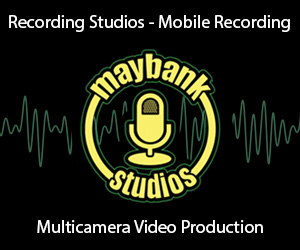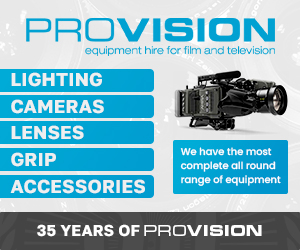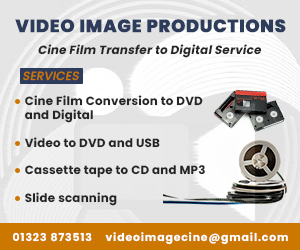Broadcast News
10/11/2016
Best Practice For Avoiding Data Loss

We all know the importance of the data and footage we shoot, either for yourself or for that important client, writes Barry Bassett, VMI, and Grant Woods, LC Technology.
Should the unthinkable happen and you lose your data, whether it be by deleting the wrong file or formatting the wrong card, seeing the dreaded 'card error' message, or worse still your card becomes corrupted and unreadable, it can be a stressful time.
This article gives some useful tips to prevent this from happening and to know what to do if you are unlucky enough to experience it.
Section 1: Common causes and preventing data loss
Preventing the loss of data in the first place is vital. Memory cards can be fragile and deserve respect, since data loss is at best inconvenient and worst a disaster, so here are some useful tips to avoid this from happening to you.
Use only reputable brands
Ensure that you only use brands from reputable manufacturers like Sony, Sandisk, etc. Don't buy cheap cards online that are priced lower than they should be, as these are probably counterfeit cards, and perhaps not of the true capacity or integrity.
Use a compatible card reader to transfer your files. These devices are easy to set up and use and make the transfer of photo and video from your camera faster, and also prevent problems that can occur with camera battery issues.
Most card readers are inexpensive, but it is worth checking it is compatible with your exact card and paying a little extra if you shoot important data and on high end cards. Some SD readers for example do not support SDHC or SDXC cards, so check.
Don't pull the card out while it is in use
Whether it is in the camera or in a reader attached to the computer, do NOT pull the card before it is finished being written to as this will cause trouble.
Any missing data will cause an error that the camera can't overcome. Sometimes it will cause a corruption and tell you that you need to reformat the card.
Even when you think the camera or computer is done writing to the card, particularly with HD video due to buffering, allow an extra minute or so to be sure and turn the camera off before removing the card.
Environmental concerns
Temperature extremes can ruin memory cards, so beware!
Even specialty cards rated for extreme temperatures are only good to about 50˚C (120˚F) so try not to expose your devices to extreme heat.
Be wary of water too. Fresh water may not be a disaster as long as the card is dried before it is plugged into the device so it won't short out, but with salt water it becomes more complex due to corrosion. Any flash card that gets wet needs to be dried thoroughly.
Moisture and dirt are also causes of failure. The contact points on memory cards can become dirty and cause a poor connection or short.
If you can see the connectors, you can keep them clean them with a couple of drops of isopropyl alcohol on a cotton-tipped swab.
The bad news is if you can see the contacts, you can also touch them and this can cause a static jolt that can destroy the card too, so avoid touching the contacts and always keep the device in a protective case when it is not in the camera or card reader.
Taking the memory card out of one camera to use in another model of camera
This may sound harmless but it changes the format and changes the file structure. Every device has its own format and numbering sequence. Have a card specifically for each device you use, so if you take your camera card and use it in your MP3 player, phone or another device, it will have to be formatted in the camera you then want to use it in before use.
If you must use the same card in different devices, save all of the data to your computer first and then format the card in the new device.
Use the write-protect function on cards
Many professional cards have write/protect tabs which prevent data being written. As soon as you remove a card from a camera, activating the write/protect tab will prevent your PC/Mac or camera from being able to write to the card. This may minimise overwriting existing data or even causing a corruption. Good practise if you work in a busy environment and someone could pick your card up. If this tab exists, then do use it.
Low batteries in the camera
Keep an eye on battery levels. If you do transfer data by camera and the battery goes too low during the downloading process you risk losing your data and possibly corrupting the card.
Low batteries during shooting can also prevent all of the necessary information from getting to the card. Do not use a camera with low batteries or you risk losing the last file as it may not finalise, or worse still, the whole card due to a corruption.
Static
Watch out for carpets and static, because static electricity can easily corrupt a card.
Physical damage
Dropping or bending your card will cause problems; breaking circuits, loosening components or worse still, damaging the internal memory chip itself, so eject and handle with care.
Do not place your card in the back pocket or let the dog near it!
Again, always keep the device in a protective case when it is not in the camera or card reader.
Backup Strategy and Making a Disaster Recovery Plan
Although memory cards can fail and become corrupted before or during backup, where possible your data can also be protected by automating backups.
Individuals can set up automated external hard drive or cloud services to back up on a schedule. By establishing routine backups, you can ensure they will lose the bare minimum of data in the event of a failure.
Individuals should follow the lead of businesses by establishing a formal written disaster recovery plan. This can be as simple as setting a routine for data backup, or instituting multiple levels of redundancy such as cloud backups combined with external HDDs kept at a separate address. This is known as the 3-2-1 theory of backup.
Establishing a plan will make data recovery simple and efficient.
Using cloud services is a great way to get off-premises backup, especially for large video files. The costs of cloud storage have plummeted, so think about using more than one service for redundancy. Consider storing financial or sensitive information on multiple password protected HDDs instead as cloud services can possibly be exploited by hackers, so combine and use multiple backup options.
Section 2: Media card types and best practice
Whatever device you use there are good practises to help avoid issues. Here are some things to consider depending what type of card you are using.
Micro SD cards
Handle with care. A cracked or physically broken MicroSD card means you will almost certainly lose your data.
Does your card reader support your type of SD card?
• SD card = 2GB
• SDHC = 4GB – 32GB
• SDXC = 64GB+
Some card readers do not support some SD cards even though the slot size is the same, so it can cause corruption.
Always keep the card in a protective case when not in the camera or card reader.
Always source from a reputable seller to avoid counterfeits.
SD Cards
Handle with care. Some SD cards can have a flimsy casing. Inside is one or more memory chips, damaging these chips may mean you lose your data or worse still make data recovery impossible.
Does your card reader support your type of SD card?
• SD card = 2GB
• SDHC = 4GB – 32GB
• SDXC = 64GB +
Some card readers do not support some SD cards even though the slot size is the same, so it can cause corruption.
Always keep the card in a protective case when not in the camera or card reader.
Always source from a reputable seller to avoid counterfeits.
CF cards
Check periodically that the pins on your card reader, and camera, are lined up and how they should be. If you see a bent pin in your reader it is time to replace it.
If you see one in your camera it is time to see an approved repair centre or contact the manufacturer.
Handle with care. Although the casing is generally metallic and sturdier than SD cards, the device still contains electrical components and one or more memory chips, which can be damaged causing data loss.
Broadcast cards – CFast/Cfast2 cards, P2, SxS, and XQD Cards
As professional and broadcast camcorders have evolved, so too has the media technology that they use.
The development of technologies like XQD, P2 Express, XDCAM/XDCAM Pro + & CFast address the increasing capabilities of today's cameras, as well as the ever-growing demands placed on professional photographers and camera operators shooting bigger and bigger files.
Make sure your camera can utilise all the speed your card can deliver. Consult your instruction manual or search the manufacturer's website for the fastest card speeds supported. Many will also recommend specific cards and warn of incompatible cards.
Also, check the card reader can support your type and speed of card to lower the chances of a corruption.
Ensure the card is not removed from any device while it is still writing.
Always know what file system your device is. Many broadcast cameras use the exFAT or UDF file systems. Always check you are following the guidelines and if using a new card it is good practise to format it in the camera you are using to prepare it for that environment.
SSD Drives
As cards become larger, the distinction between memory cards and SSDs becomes blurred. Many of today's high end cameras record to SSD drives, as do many off-board HD video recorders as well. Unlike hard disk drives, solid state drives store data in flash memory chips.
Data loss can occur with SSD storage devices due to physical damage to the flash chips and how data is logically stored on them.
Here are some common failure types with SSD drives:
• Electronic component failure
• Controller chip failure
• Flash cell degradation from natural use
• Power surges or failures
• Damage to printed circuit boards
• Damage to connectors
• Data corruption after firmware updates.
Additionally, SSD storage devices are not immune from traditional data loss events such as human error, computer viruses, natural disasters, and software/program corruption.
Handle with care. Keep an eye on your battery levels and follow the guidelines from the camera manufacturer.
Section 3: What to do if you lose data
Even the best laid data protection plans can be thwarted by bad luck, corruptions or failures. If you are confronted with a data loss, there are only limited options available and it is possible that you can do more harm than good from trying to recover data where a loss has occurred.
I myself remember a situation, where upon mounting a P2 card that I knew already had data on it into a Mac, was presented with being asked to 'Initialise a Drive'. That seemed like a good idea at the time...
At this point, if this happens to you, then you should stop what you are doing and contact the manufacturer or a reputable data recovery company for advice.
If the data recovery company is any good, then they will offer you free support and can guide you to pursue various strategies which may help you to recover your media without cost to you.
Losing data due to human error such as deletion or formatting may sometimes be recoverable using specific software tools but this is by no means a caveat for cavalier data management. Whilst there are many free file and data recovery utilities, that is often a “get what you pay for” proposition, as these tools can be riddled with malware and do not offer any level of support, and they are often useless with today's more complex files and file systems.
Finally, if your issue is more complex or serious than a simple delete – such as a seemingly dead or badly corrupted device – and the data is of importance, then you may require sending the device off for a lab recovery. Sometimes this is the only option to you.
Over the years, we have had many clients who have believed their data to have been irretrievable but still managed to recover their data in full.
Our advice is simple – if your data is important, then seek an expert!
VMI recommend LC Technology who are experts in data recovery of files stored on flash media and hard drives and and they do offer free support. At the very least, call them to use their free support and see if this helps you to rectify your situation with a DIY solution.
The following guide to remedial data recovery was written by LC Technology and we are grateful for their input into this article and important area.
Section 4: The LC Technology Guide to Remedial Data Recovery
LC Tech provide both software tools and lab services to over 100 countries and are recommended by many of the major manufacturers of both memory cards and cameras including SanDisk, Canon and Sony, as well as suppliers to the BBC and ITV, due to their experience and expertise with reading memory chips.
• LC Technology has written tools for the likes of SanDisk and Toshiba for over a decade, and will guide you through the process
• Their tools can be tested as an evaluation and unlike many freeware solutions they have tools suitable to recover complex HD video recoveries, which typically need to be recovered in their original folder structure
• Their FILERECOVERY software can be downloaded here on a try-before-you-buy evaluation basis for PC or MAC
• LC Technology can perform chip (NAND) reads, whereby the memory chip is removed from the device to attempt to access the raw data for reassembling
• A complex forensic data recovery if the data is of value is a real lifesaver.
Full details of LC Technology's services can be found here.
www.vmi.tv
Article credit: VMI and LC Technology.
(JP/LM)
Should the unthinkable happen and you lose your data, whether it be by deleting the wrong file or formatting the wrong card, seeing the dreaded 'card error' message, or worse still your card becomes corrupted and unreadable, it can be a stressful time.
This article gives some useful tips to prevent this from happening and to know what to do if you are unlucky enough to experience it.
Section 1: Common causes and preventing data loss
Preventing the loss of data in the first place is vital. Memory cards can be fragile and deserve respect, since data loss is at best inconvenient and worst a disaster, so here are some useful tips to avoid this from happening to you.
Use only reputable brands
Ensure that you only use brands from reputable manufacturers like Sony, Sandisk, etc. Don't buy cheap cards online that are priced lower than they should be, as these are probably counterfeit cards, and perhaps not of the true capacity or integrity.
Use a compatible card reader to transfer your files. These devices are easy to set up and use and make the transfer of photo and video from your camera faster, and also prevent problems that can occur with camera battery issues.
Most card readers are inexpensive, but it is worth checking it is compatible with your exact card and paying a little extra if you shoot important data and on high end cards. Some SD readers for example do not support SDHC or SDXC cards, so check.
Don't pull the card out while it is in use
Whether it is in the camera or in a reader attached to the computer, do NOT pull the card before it is finished being written to as this will cause trouble.
Any missing data will cause an error that the camera can't overcome. Sometimes it will cause a corruption and tell you that you need to reformat the card.
Even when you think the camera or computer is done writing to the card, particularly with HD video due to buffering, allow an extra minute or so to be sure and turn the camera off before removing the card.
Environmental concerns
Temperature extremes can ruin memory cards, so beware!
Even specialty cards rated for extreme temperatures are only good to about 50˚C (120˚F) so try not to expose your devices to extreme heat.
Be wary of water too. Fresh water may not be a disaster as long as the card is dried before it is plugged into the device so it won't short out, but with salt water it becomes more complex due to corrosion. Any flash card that gets wet needs to be dried thoroughly.
Moisture and dirt are also causes of failure. The contact points on memory cards can become dirty and cause a poor connection or short.
If you can see the connectors, you can keep them clean them with a couple of drops of isopropyl alcohol on a cotton-tipped swab.
The bad news is if you can see the contacts, you can also touch them and this can cause a static jolt that can destroy the card too, so avoid touching the contacts and always keep the device in a protective case when it is not in the camera or card reader.
Taking the memory card out of one camera to use in another model of camera
This may sound harmless but it changes the format and changes the file structure. Every device has its own format and numbering sequence. Have a card specifically for each device you use, so if you take your camera card and use it in your MP3 player, phone or another device, it will have to be formatted in the camera you then want to use it in before use.
If you must use the same card in different devices, save all of the data to your computer first and then format the card in the new device.
Use the write-protect function on cards
Many professional cards have write/protect tabs which prevent data being written. As soon as you remove a card from a camera, activating the write/protect tab will prevent your PC/Mac or camera from being able to write to the card. This may minimise overwriting existing data or even causing a corruption. Good practise if you work in a busy environment and someone could pick your card up. If this tab exists, then do use it.
Low batteries in the camera
Keep an eye on battery levels. If you do transfer data by camera and the battery goes too low during the downloading process you risk losing your data and possibly corrupting the card.
Low batteries during shooting can also prevent all of the necessary information from getting to the card. Do not use a camera with low batteries or you risk losing the last file as it may not finalise, or worse still, the whole card due to a corruption.
Static
Watch out for carpets and static, because static electricity can easily corrupt a card.
Physical damage
Dropping or bending your card will cause problems; breaking circuits, loosening components or worse still, damaging the internal memory chip itself, so eject and handle with care.
Do not place your card in the back pocket or let the dog near it!
Again, always keep the device in a protective case when it is not in the camera or card reader.
Backup Strategy and Making a Disaster Recovery Plan
Although memory cards can fail and become corrupted before or during backup, where possible your data can also be protected by automating backups.
Individuals can set up automated external hard drive or cloud services to back up on a schedule. By establishing routine backups, you can ensure they will lose the bare minimum of data in the event of a failure.
Individuals should follow the lead of businesses by establishing a formal written disaster recovery plan. This can be as simple as setting a routine for data backup, or instituting multiple levels of redundancy such as cloud backups combined with external HDDs kept at a separate address. This is known as the 3-2-1 theory of backup.
Establishing a plan will make data recovery simple and efficient.
Using cloud services is a great way to get off-premises backup, especially for large video files. The costs of cloud storage have plummeted, so think about using more than one service for redundancy. Consider storing financial or sensitive information on multiple password protected HDDs instead as cloud services can possibly be exploited by hackers, so combine and use multiple backup options.
Section 2: Media card types and best practice
Whatever device you use there are good practises to help avoid issues. Here are some things to consider depending what type of card you are using.
Micro SD cards
Handle with care. A cracked or physically broken MicroSD card means you will almost certainly lose your data.
Does your card reader support your type of SD card?
• SD card = 2GB
• SDHC = 4GB – 32GB
• SDXC = 64GB+
Some card readers do not support some SD cards even though the slot size is the same, so it can cause corruption.
Always keep the card in a protective case when not in the camera or card reader.
Always source from a reputable seller to avoid counterfeits.
SD Cards
Handle with care. Some SD cards can have a flimsy casing. Inside is one or more memory chips, damaging these chips may mean you lose your data or worse still make data recovery impossible.
Does your card reader support your type of SD card?
• SD card = 2GB
• SDHC = 4GB – 32GB
• SDXC = 64GB +
Some card readers do not support some SD cards even though the slot size is the same, so it can cause corruption.
Always keep the card in a protective case when not in the camera or card reader.
Always source from a reputable seller to avoid counterfeits.
CF cards
Check periodically that the pins on your card reader, and camera, are lined up and how they should be. If you see a bent pin in your reader it is time to replace it.
If you see one in your camera it is time to see an approved repair centre or contact the manufacturer.
Handle with care. Although the casing is generally metallic and sturdier than SD cards, the device still contains electrical components and one or more memory chips, which can be damaged causing data loss.
Broadcast cards – CFast/Cfast2 cards, P2, SxS, and XQD Cards
As professional and broadcast camcorders have evolved, so too has the media technology that they use.
The development of technologies like XQD, P2 Express, XDCAM/XDCAM Pro + & CFast address the increasing capabilities of today's cameras, as well as the ever-growing demands placed on professional photographers and camera operators shooting bigger and bigger files.
Make sure your camera can utilise all the speed your card can deliver. Consult your instruction manual or search the manufacturer's website for the fastest card speeds supported. Many will also recommend specific cards and warn of incompatible cards.
Also, check the card reader can support your type and speed of card to lower the chances of a corruption.
Ensure the card is not removed from any device while it is still writing.
Always know what file system your device is. Many broadcast cameras use the exFAT or UDF file systems. Always check you are following the guidelines and if using a new card it is good practise to format it in the camera you are using to prepare it for that environment.
SSD Drives
As cards become larger, the distinction between memory cards and SSDs becomes blurred. Many of today's high end cameras record to SSD drives, as do many off-board HD video recorders as well. Unlike hard disk drives, solid state drives store data in flash memory chips.
Data loss can occur with SSD storage devices due to physical damage to the flash chips and how data is logically stored on them.
Here are some common failure types with SSD drives:
• Electronic component failure
• Controller chip failure
• Flash cell degradation from natural use
• Power surges or failures
• Damage to printed circuit boards
• Damage to connectors
• Data corruption after firmware updates.
Additionally, SSD storage devices are not immune from traditional data loss events such as human error, computer viruses, natural disasters, and software/program corruption.
Handle with care. Keep an eye on your battery levels and follow the guidelines from the camera manufacturer.
Section 3: What to do if you lose data
Even the best laid data protection plans can be thwarted by bad luck, corruptions or failures. If you are confronted with a data loss, there are only limited options available and it is possible that you can do more harm than good from trying to recover data where a loss has occurred.
I myself remember a situation, where upon mounting a P2 card that I knew already had data on it into a Mac, was presented with being asked to 'Initialise a Drive'. That seemed like a good idea at the time...
At this point, if this happens to you, then you should stop what you are doing and contact the manufacturer or a reputable data recovery company for advice.
If the data recovery company is any good, then they will offer you free support and can guide you to pursue various strategies which may help you to recover your media without cost to you.
Losing data due to human error such as deletion or formatting may sometimes be recoverable using specific software tools but this is by no means a caveat for cavalier data management. Whilst there are many free file and data recovery utilities, that is often a “get what you pay for” proposition, as these tools can be riddled with malware and do not offer any level of support, and they are often useless with today's more complex files and file systems.
Finally, if your issue is more complex or serious than a simple delete – such as a seemingly dead or badly corrupted device – and the data is of importance, then you may require sending the device off for a lab recovery. Sometimes this is the only option to you.
Over the years, we have had many clients who have believed their data to have been irretrievable but still managed to recover their data in full.
Our advice is simple – if your data is important, then seek an expert!
VMI recommend LC Technology who are experts in data recovery of files stored on flash media and hard drives and and they do offer free support. At the very least, call them to use their free support and see if this helps you to rectify your situation with a DIY solution.
The following guide to remedial data recovery was written by LC Technology and we are grateful for their input into this article and important area.
Section 4: The LC Technology Guide to Remedial Data Recovery
LC Tech provide both software tools and lab services to over 100 countries and are recommended by many of the major manufacturers of both memory cards and cameras including SanDisk, Canon and Sony, as well as suppliers to the BBC and ITV, due to their experience and expertise with reading memory chips.
• LC Technology has written tools for the likes of SanDisk and Toshiba for over a decade, and will guide you through the process
• Their tools can be tested as an evaluation and unlike many freeware solutions they have tools suitable to recover complex HD video recoveries, which typically need to be recovered in their original folder structure
• Their FILERECOVERY software can be downloaded here on a try-before-you-buy evaluation basis for PC or MAC
• LC Technology can perform chip (NAND) reads, whereby the memory chip is removed from the device to attempt to access the raw data for reassembling
• A complex forensic data recovery if the data is of value is a real lifesaver.
Full details of LC Technology's services can be found here.
www.vmi.tv
Article credit: VMI and LC Technology.
(JP/LM)
Useful Links
Top Related Stories
Click here for the latest broadcast news stories.
27/05/2022
Sonnet Announces The McFiver™ PCIe® Card
Sonnet Technologies has announced the McFiver™ PCIe® Card, the latest offering in the company's expansive family of computer adapter cards. The McFive
Sonnet Announces The McFiver™ PCIe® Card
Sonnet Technologies has announced the McFiver™ PCIe® Card, the latest offering in the company's expansive family of computer adapter cards. The McFive
21/11/2012
Memory Card Launched To Unleash Potential Of Mobile Devices
Kingston Digital Europe Ltd has launched a new 64GB Kingston microSDXC Class 10 memory card. In the current age of smartphones and tablets, the need f
Memory Card Launched To Unleash Potential Of Mobile Devices
Kingston Digital Europe Ltd has launched a new 64GB Kingston microSDXC Class 10 memory card. In the current age of smartphones and tablets, the need f
24/06/2022
Sonnet Announces PCI Express 3.0 Adapter Card
Sonnet Technologies has announced the Sonnet M.2 2x4 Low-Profile PCIe® Card, the latest offering in the company's popular family of high-performance s
Sonnet Announces PCI Express 3.0 Adapter Card
Sonnet Technologies has announced the Sonnet M.2 2x4 Low-Profile PCIe® Card, the latest offering in the company's popular family of high-performance s
03/06/2015
Sonnet Unveils Allegro Pro USB 3.0 PCIe
Sonnet Technologies has unveiled the Allegro Pro USB 3.0 PCIe, a 4-port, 4-controller SuperSpeed USB 3.0 PCI Express 2.0 adapter card with charging ca
Sonnet Unveils Allegro Pro USB 3.0 PCIe
Sonnet Technologies has unveiled the Allegro Pro USB 3.0 PCIe, a 4-port, 4-controller SuperSpeed USB 3.0 PCI Express 2.0 adapter card with charging ca
08/12/2017
VMEDIA: For Memory Card & SSD Media Hire
VMEDIA is a rental division of VMI, set up in 2017 in response to a growing demand for memory card hire and SSD media hire. We supply all popular form
VMEDIA: For Memory Card & SSD Media Hire
VMEDIA is a rental division of VMI, set up in 2017 in response to a growing demand for memory card hire and SSD media hire. We supply all popular form
07/11/2014
New Single-Slot P2 Memory Card With Thunderbolt Interface Launches
Sonnet Technologies has launched its new single-slot P2 memory card reader with a Thunderbolt™ interface. The Thunderbolt Pro P2 Card Reader is a rugg
New Single-Slot P2 Memory Card With Thunderbolt Interface Launches
Sonnet Technologies has launched its new single-slot P2 memory card reader with a Thunderbolt™ interface. The Thunderbolt Pro P2 Card Reader is a rugg
18/04/2012
Sonnet Now Shipping SxS Memory Card Reader
Sonnet Technologies has announced that the Echo ExpressCard Thunderbolt Adapter, which enables the use of many Sonnet ExpressCard/34 cards with comput
Sonnet Now Shipping SxS Memory Card Reader
Sonnet Technologies has announced that the Echo ExpressCard Thunderbolt Adapter, which enables the use of many Sonnet ExpressCard/34 cards with comput
08/03/2007
Movie On Your Mobile Memory Card Release From Sony And Sterkinekor
Sony Pictures and SterKinekor Home Entertainment have announced the release of the first movie on a mobile phone compatible memory card in South Afric
Movie On Your Mobile Memory Card Release From Sony And Sterkinekor
Sony Pictures and SterKinekor Home Entertainment have announced the release of the first movie on a mobile phone compatible memory card in South Afric
28/02/2007
Panasonic Adds Value to P2 Tapeless Memory Card System
Outstanding value for money and greater appeal to the broadest possible range of professional video users are the key drivers behind the latest sales
Panasonic Adds Value to P2 Tapeless Memory Card System
Outstanding value for money and greater appeal to the broadest possible range of professional video users are the key drivers behind the latest sales
15/05/2006
Memory card protection from Lowepro
Lowepro has launched a range of memory card cases which prove that good things come in small packages. The compact PixelPak V1 and V2 cases hold all s
Memory card protection from Lowepro
Lowepro has launched a range of memory card cases which prove that good things come in small packages. The compact PixelPak V1 and V2 cases hold all s
21/06/2024
Sonnet Unveils Allegro™ Max USB-C® 20Gbps 1-Port PCIe® Card
Sonnet Technologies has announced the Allegro™ Max USB-C® 20Gbps 1-Port PCIe® Card, a new, low-cost addition to Sonnet's broad range of USB adapter ca
Sonnet Unveils Allegro™ Max USB-C® 20Gbps 1-Port PCIe® Card
Sonnet Technologies has announced the Allegro™ Max USB-C® 20Gbps 1-Port PCIe® Card, a new, low-cost addition to Sonnet's broad range of USB adapter ca
10/10/2022
Stage Precision Streamlines Position And Camera Tracking Data With AJA I/O Cards
For live event, installation, and broadcast AR workflows, managing large volumes of data from different protocols and technology manufacturers has pro
Stage Precision Streamlines Position And Camera Tracking Data With AJA I/O Cards
For live event, installation, and broadcast AR workflows, managing large volumes of data from different protocols and technology manufacturers has pro
15/04/2008
Codex Digital Announces Data Support For ARRI D-21 Camera
Codex Digital, a specialist in high-resolution media recording and workflow, has announced the extension of its HD 2K 4K systems, that record from lea
Codex Digital Announces Data Support For ARRI D-21 Camera
Codex Digital, a specialist in high-resolution media recording and workflow, has announced the extension of its HD 2K 4K systems, that record from lea
17/10/2024
Sonnet Technologies Launches The Allegro™ 7-Port USB 3.2 Gen 1 Type A PCIe® Card
Sonnet Technologies has launched the Allegro™ 7-Port USB 3.2 Gen 1 Type A PCIe® Card, a new cost-effective addition to Sonnet's broad range of USB ada
Sonnet Technologies Launches The Allegro™ 7-Port USB 3.2 Gen 1 Type A PCIe® Card
Sonnet Technologies has launched the Allegro™ 7-Port USB 3.2 Gen 1 Type A PCIe® Card, a new cost-effective addition to Sonnet's broad range of USB ada
16/08/2023
Sonnet Announces PCI Express® 4.0 Adapter Card
Sonnet Technologies has announced the Sonnet M.2 8x4 Silent Gen4 PCIe® Card, the latest offering in the company's popular family of high-performance s
Sonnet Announces PCI Express® 4.0 Adapter Card
Sonnet Technologies has announced the Sonnet M.2 8x4 Silent Gen4 PCIe® Card, the latest offering in the company's popular family of high-performance s















